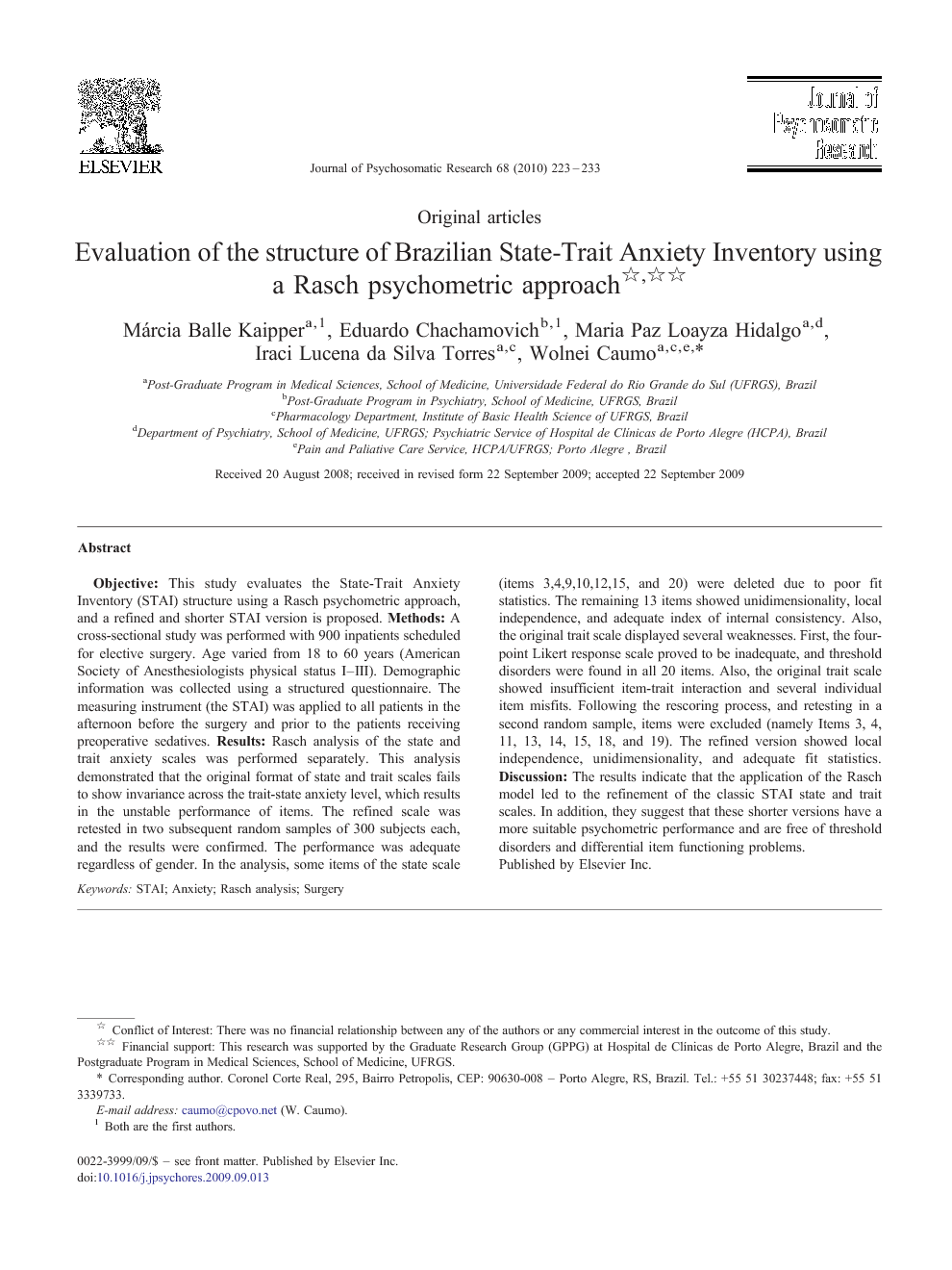Objective
This study evaluates the State-Trait Anxiety Inventory (STAI) structure using a Rasch psychometric approach, and a refined and shorter STAI version is proposed.
Methods
A cross-sectional study was performed with 900 inpatients scheduled for elective surgery. Age varied from 18 to 60 years (American Society of Anesthesiologists physical status I–III). Demographic information was collected using a structured questionnaire. The measuring instrument (the STAI) was applied to all patients in the afternoon before the surgery and prior to the patients receiving preoperative sedatives.
Results
Rasch analysis of the state and trait anxiety scales was performed separately. This analysis demonstrated that the original format of state and trait scales fails to show invariance across the trait-state anxiety level, which results in the unstable performance of items. The refined scale was retested in two subsequent random samples of 300 subjects each, and the results were confirmed. The performance was adequate regardless of gender. In the analysis, some items of the state scale (items 3,4,9,10,12,15, and 20) were deleted due to poor fit statistics. The remaining 13 items showed unidimensionality, local independence, and adequate index of internal consistency. Also, the original trait scale displayed several weaknesses. First, the four-point Likert response scale proved to be inadequate, and threshold disorders were found in all 20 items. Also, the original trait scale showed insufficient item-trait interaction and several individual item misfits. Following the rescoring process, and retesting in a second random sample, items were excluded (namely Items 3, 4, 11, 13, 14, 15, 18, and 19). The refined version showed local independence, unidimensionality, and adequate fit statistics.
Discussion
The results indicate that the application of the Rasch model led to the refinement of the classic STAI state and trait scales. In addition, they suggest that these shorter versions have a more suitable psychometric performance and are free of threshold disorders and differential item functioning problems.
Most patients awaiting elective surgery experience preoperative anxiety [1], [2], [3] and [4]. The incidence of preoperative anxiety has been reported to range from 11% to 80% among adult patients [5]. This widely range may be explained in part by the assessment methods.
The State-Trait Anxiety Inventory (STAI) is the gold standard for anxiety evaluation used in more than one thousand peer-reviewed studies [6]. The STAI-Form X was published in 1970 [7], and its revision began in 1979. The STAI comprises separate self-report scales for measuring the state (anxiety refers to acute situation-driven episodes and fluctuates over time), and the trait anxiety (a lifelong pattern of anxiety, a personality feature) [8], [9] and [10]. The S-Anxiety Scale (STAI-S) consists of twenty statements that evaluate how the respondent feels “right now,” at this moment. The T-Anxiety Scale (STAI-T) consists in twenty statements that evaluate how the respondent feels “generally”. The refined version of the STAI-Form X changed around 25% of the questions and it was denominate STAI Form Y (1983) [8] However, the STAI Form Y persists with the 20 multiple-choice questions for state anxiety and 20 questions for trait anxiety and its structure was based in the classic psychometric parameters. Additionally, it is important to emphasize that even so being the STAI Form Y, the STAI-Form X persist the instrument more widely used to assess state-trait anxiety [5] and [11]. Thus, it is essential to examine more in depth the STAI-Form X to determine the effectiveness of interventions directed at reducing such anxiety. This is especially true because previous reports have demonstrated that anesthesiologists appear to be inaccurate in assessing patient anxiety during the preoperative visit [1] and [12]. This moment of the perioperative period is when the patient's anxiety should be predicted with higher accuracy to allow the identification of patients with high anxiety, so that appropriate steps can be taken to alleviate this anxiety.
Given the importance of studying anxiety across cultures and the need to establish cross-cultural equivalence of instruments, it is important to investigate the psychometric properties of the STAI using a statistical approach, such as Rasch analysis, to investigate the structure of the STAI more in depth. It is important for theory and research, since an instrument could assess anxiety appropriately independent of the situation in which it is experienced or of the interpretation of its meaning. The Rasch measurement theory is a modern psychometric approach for the development and validation of instruments. It has emerged as a powerful tool for examining the performance of an instrument in depth, allowing both the instrument as whole and individual items to be assessed. In addition, the Rasch model is also helpful in providing potential solutions for misperforming instruments. It is suggested that combining both traditional and modern psychometric approaches is a fruitful strategy to enhance the power of validation processes [13]. Furthermore, the use of the Rasch measurement model for the development and application of mental health instruments has been increasingly stressed [14] and [15].
The present paper evaluates the STAI-Form X structure using a Rasch psychometric approach, and a refined and shorter STAI-Form X version is proposed. In addition, the discriminate properties of the original STAI-Form X and their reduced forms were used to identify patients more disposed to present higher postoperative pain.


